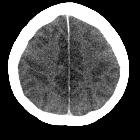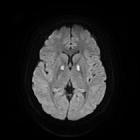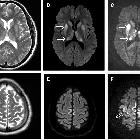carbon monoxide (CO) poisoning















Carbon monoxide (CO) poisoning may result in an anoxic-ischemic encephalopathy, with acute as well as delayed effects.
Epidemiology
Carbon monoxide poisoning is mostly preventable with common causes including malfunctioning heating systems, improperly ventilated motor vehicles, and residential fires . It is also observed as an attempt to commit suicide.
Clinical presentation
Patients can present with :
- acute symptoms of headache, dizziness, altered conscious state, seizures
- cardiac arrest may occur, see pulseless electrical activity (PEA)
- chronic symptoms of cognitive decline, abnormal gait, fecal incontinence
Pathology
The pathophysiology can be two fold:
- carbon monoxide strongly binds to hemoglobin and the resultant carboxyhemoglobinin the bloodstream can cause profound hypoxic/anoxic injury
- carbon monoxide is also a respiratory chain metabolism toxin that interferes with mitochondrial oxidative phosphorylation and activates polymorphonuclear leukocytes, which undergo diapedesis and cause brain lipid peroxidation; this results in the delayed effects of carbon monoxide poisoning
Radiographic features
Changes tend to be bilateral with the globus pallidus most commonly affected .
CT
Classically seen as low attenuation in the globus pallidus region. Other features include diffuse hypoattenuation in cerebral white matter .
MRI
Regions of involvement are similar to CT. Signal characteristics include:
- T1: affected areas are usually low signal, hemorrhagic areas can be high signal
- T2/FLAIR: affected areas are high signal
- T1 C+ (Gd): can show patchy peripheral enhancement in affected areas in the acute phase
- DWI: affected areas show increased diffusion signal in the acute phase
Treatment and prognosis
Treatment consists of administering 100% oxygen which accelerates the elimination of carboxyhemoglobin .
Differential diagnosis
For involvement in and around the globus pallidus, consider:
- mitochondrial encephalopathies: tends to affect other basal ganglia regions
- other toxic encephalopathies
- cyanide neurotoxicity: tends to also affect the cortex
- methanol neurotoxicity: tends to affect the putamen
- organophosphate neurotoxicity
- other causes of anoxia
- metabolic disorders
- prion encephalopathies
Siehe auch:
- hypoxischer Hirnschaden
- Globus pallidus
- T2 hyperintense Basalganglien
- Morbus Wilson
- Leigh-Syndrom
- Creutzfeldt-Jakob-Krankheit
- Kearns-Sayre-Syndrom
- toxische Enzephalopathie
und weiter:

 Assoziationen und Differentialdiagnosen zu Kohlenmonoxidintoxikation:
Assoziationen und Differentialdiagnosen zu Kohlenmonoxidintoxikation:






